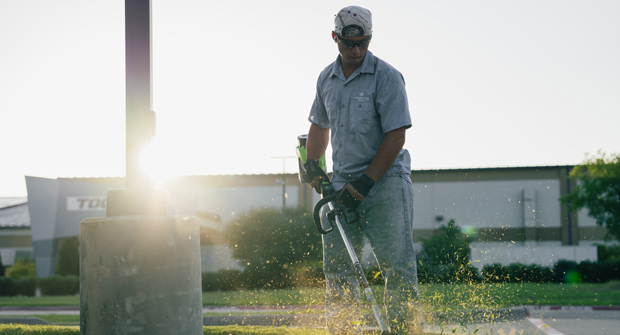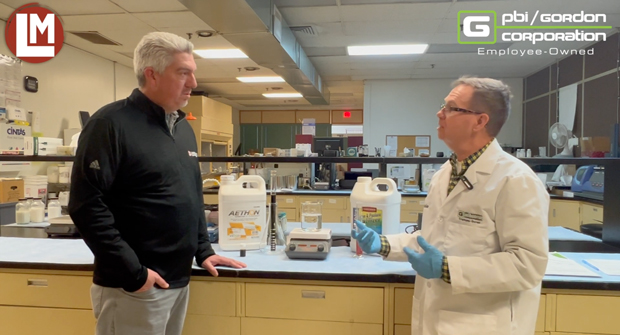[SPONSORED CONTENT] Editor-in-Chief Scott Hollister stops by the PBI-Gordon lab to meet with Dale Sanson, Ph.D., senior director of formulation development in compliance chemistry, to learn about Atrimmec® Plant Growth Regulator.
This video is sponsored content by PBI-Gordon.
Transcription:
SH: Scott Hollister
DS: Dr. Dale Sanson
SH: Hi everybody. It’s Scott Hollister with Landscape Management magazine, and we are near downtown Kansas City, Missouri, this morning with our friends from PBI-Gordon and Dr. Dale Sanson. Dr. Dale is the senior director of formulation development and compliance chemistry for PBI-Gordon, and giving us a little look around the lab today, and kind of an inside look at a couple of the products that PBI-Gordon has on the market. And we’re going to talk in this video about Atrimmec®, which is a plant growth regulator, a PGR. I am familiar on my background with PGRs, mainly for turf grass, but this one has a little different focus. Dr. Dale.
DS: Well, thank you, Scott. Atrimmec® has been in our portfolio for quite some time. It’s a plant growth regulator, for those that aren’t familiar with what that is, PGR, plant growth regulator, used as an application aid in the ornamental market. After you do the trimming, you apply Atrimmec®, you can get more longevity on that trim, so you don’t have to go back and trim again. It’s a great formula. It’s a water based product. I’ve got a viewing tube here that you can kind of see. It’s got that characteristic blue, green color mixes very well in spray tanks, so it makes a very good candidate for a spray tank partner in terms of mix ability. The one thing that sets this apart, compared to most plant growth regulators, it does not have an odor. This is a water based product, great for landscape management because you can put it around areas where you’re going to have people, buildings, offices. You don’t have that typical off putting smell that you would normally have with a plant growth regulator, great formula. There are several good attributes, besides just the chemical pinching that I talked about. It controls nuisance fruit that’s very important for landscape management. You can use it as bark banding. If you look at the label, there’s kind of a guide on how you do that. The other thing that’s nice about this, just aside from bark banding, it is a systemic product, so it can be soil drenched, taken into the plant, and still get a good mode of action.
SH: Some of the questions that you and your team get revolve around tank mixing with this product. And this, as you told, told us, this product can be tank mixed with some insecticides, and we have a kind of a visual aid we’re going to show you here. Kind of walk us through that.
DS: Everybody likes the magic of a stir plate. So I thought this would be a good demo. The application time with Atrimmec® fits so good with an insecticide application. So what we’re going to do is to step you through the proper way to mix Atrimmec® with an insecticide. You’re seeing more and more preponderance of non-synthetic insecticides on the market. They’re typically formulated as WPs, wettable powders. So when you’re putting together a spray tank recipe, if you will, wettable powders need to be added first to ensure proper wetting. So I’ve got these weighed out in the proper amount, so I’m going to add this insecticide in there, and you see how well it goes in. And it’s mixing well. Very important that you add a wettable powder first to allow intimate mixing with the water and wetting. You see, it’s taking a little bit of time, but with some agitation, it’s starting to go into solution. While that’s mixing, one thing I want to talk about is an SDS, very valuable document here: Section nine. If you go to the physical, chemical properties of your components, it will allow you to determine if something will be compatible in a spray tank. Look at the pH. If you’re within two pH units of the tank mix partner, you’re probably guaranteed for success. Alright, we’ve mixed. It looks good. It’s nice and uniform. The next thing you’re going to do is add your Atrimmec®, so you’ll add the Atrimmec®, and this is weighed out in the proper proportion. And as I said, look how easy that goes in. Your wettable powder has been wetted. It’s uniform throughout. After that, one thing that I like to talk about adding to give you a little more punch, is a siloxane surfactant. For plant growth regulators, this really helps to give you that extra push to get the properties that you need. Very important if you’re going to do bark banding for nuisance fruit management, and there you have a successful tank mix. Your day’s planned out, guaranteed success.
SH: That’s fascinating. And I’m sure for a lot of lawn care applicators, that’s going to be something maybe they don’t think about with this product. Maybe they think about only its straight use without a tank mixing option, but you’re killing multiple birds with one stone there. What has been the feedback you said the product has been on the market for a while, what sort of things do you hear from lawn care applicators on the product, and how they’ve been able to integrate it into their operations?
DS: One of the big benefits, if you go to our website, is a cost savings for labor. So there’s an actual calculator on there that you can see, based upon your plan, how much money you can save on labor. And we all know labor is expensive. The other thing is, as I said earlier, the odor, the mix ability, the ease of the product. It’s a water based product. So overall, it’s a winner.
SH: That’s fantastic. Well, obviously go to the PBI-Gordon website to check out to learn much more. Dr. Dale, thank you for your time this morning. Really appreciate it. Dr Dale, I’m Scott. Thanks for watching on Landscape Management TV.


